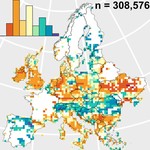Abstract
Biodiversity change forecasts rely on long-term time series, but such data are often scarce in space and time. Here, we interpolated spatiotemporal changes in species richness using a new method based on machine learning that does not require temporal replication at sites. Using 698,692 one-time sampled vegetation plots, we estimated trends in vascular plant alpha diversity across Europe and validated our approach against 22,852 independent time series. We found an overall near-zero net change in species richness between 1960 and 2020. However, species richness generally declined from 1960 to 1980 and increased from 2000 to 2020 across habitats. Declines were most pronounced in forests, but trends varied across habitats and regions, with overall increases at higher latitudes and elevations, and declines or stable trends elsewhere. Our findings demonstrate how data without temporal replication can be used to reveal context-dependent biodiversity dynamics, underscoring their importance for conservation and management.
